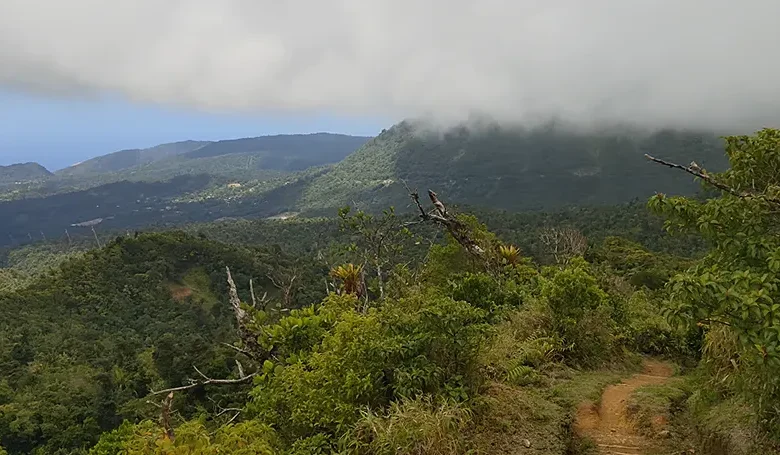Dominica’s Terrain

Dominica’s terrain is among the most striking in the Caribbean, characterized by its volcanic origins and rugged landscape. This “Nature Isle of the Caribbean” is part of the Lesser Antilles volcanic arc. It has shaped its distinctive topography, featuring towering volcanic peaks, lush valleys, dense rainforests, and numerous freshwater features. Dominica’s landscape has earned it a reputation for unparalleled natural beauty and biodiversity, making it a prime location for eco-tourism and adventure tourism.
Volcanic Origins and Key Features
Dominica’s topography is largely a result of volcanic and tectonic activity, creating dramatic elevations and geological features across the island. The island’s highest point, Morne Diablotins, rises to over 4,700 feet, while Morne Trois Pitons is a UNESCO World Heritage site notable for its unique volcanic geology, steep ridges, and valleys. The terrain also includes a range of geothermal features, such as fumaroles, hot springs, and the iconic Boiling Lake, the world’s second-largest hot lake, which reaches temperatures of nearly 200°F due to underground volcanic activity. These geothermal elements are significant tourist attractions and enhance Dominica’s natural biodiversity.
Rivers, Waterfalls, and Coastal Geography
The island’s rugged terrain supports over 365 rivers and multiple waterfalls, including the popular Trafalgar Falls and Sari-Sari Falls, which cascade down lush hillsides into scenic pools. These rivers, such as the White River, Rosalie River, Pagua River, and Layou River, originate in the mountains and flow through deep gorges, eventually emptying into the Caribbean Sea or the Atlantic Ocean. The volcanic soil along these rivers is rich in nutrients, supporting tropical flora and fauna along the riverbanks.
Dominica’s coastline is a mix of black sand beaches and cliff-lined shores, reflecting its volcanic history. The West Coast, bordered by the Edward Oliver Leblanc Highway, provides easy access to coastal villages along the Caribbean Sea and more accessible beaches such as Mero Beach and Purple Turtle Beach. By contrast, the East Coast is more secluded and rugged, with the dramatic terrain leading to fewer sandy beaches but more unique ecosystems, including areas within the Kalinago Territory, where the indigenous Kalinago people have maintained their traditional way of life. This coastline also includes hidden coves and volcanic rock formations, making it ideal for adventure tourism.
Microclimates and Biodiversity
Dominica’s mountainous and varied terrain results in distinct microclimates across the island, which influence local weather patterns and support a range of ecosystems. The windward side of Dominica, facing the Atlantic, receives higher rainfall and is home to dense, wet rainforests, while the leeward side is drier. These microclimates foster a wide range of biodiversity, from tropical rainforests filled with endemic species to drier, scrub-like vegetation on the western slopes. Dominica’s rich biodiversity includes the Sisserou Parrot, found in the rainforests of Morne Diablotin National Park, which is also the country’s national bird. The varied flora and fauna are supported by nutrient-rich volcanic soil, abundant freshwater features, and a climate moderated by elevation and proximity to the ocean.
Adventure Tourism and the Waitukubuli National Trail
Dominica’s rugged terrain is a haven for adventure tourism, offering numerous opportunities for hiking, canyoning, and river tubing. The island’s extensive Waitukubuli National Trail, which spans 115 miles and is the longest trail in the Caribbean, provides hikers access to diverse landscapes, from volcanic peaks to lush valleys and coastal paths. The trail is divided into 14 segments that allow visitors to explore Dominica’s terrain at various elevations and difficulty levels, passing through rainforests, farmlands, and remote villages. Other popular sites for adventurous activities include Morne Trois Pitons National Park, where visitors can hike to the Boiling Lake, and coastal cliffs perfect for canyoning.
Conservation and Sustainable Tourism
Due to its terrain’s rugged and ecologically sensitive nature, Dominica has prioritized conservation and sustainable tourism practices. Organizations like the Dominica Marine Association and Nature Enhancement Team (NET), as well as government initiatives, focus on protecting natural resources and mitigating the environmental impact of tourism. Sustainable practices are enforced within protected areas like national parks and the Soufriere Scotts Head Marine Reserve to ensure that tourist activities such as hiking, snorkelling, and scuba diving are conducted responsibly. Conservation efforts also address challenges posed by erosion and deforestation, with reforestation projects aiming to preserve the island’s lush landscapes and diverse ecosystems.
Sustaining Dominica’s Unique Terrain
Dominica’s rugged, mountainous terrain, marked by volcanic peaks, waterfalls, rivers, and coastal cliffs, provides a spectacular natural setting that appeals to eco-tourists and adventure seekers alike. Its landscapes are complemented by unique microclimates that sustain rich biodiversity, making Dominica one of the most ecologically diverse islands in the Caribbean. The island’s commitment to conservation and sustainable tourism ensures its natural beauty remains protected, allowing future generations to enjoy Dominica’s pristine landscapes and distinctive ecosystems.




